How and how to cool the water in the aquarium?
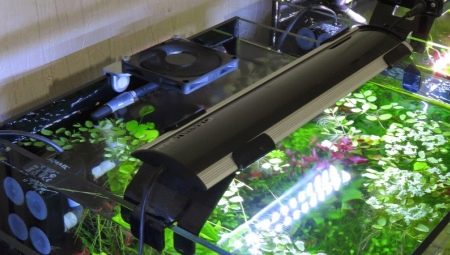
Cooling the aquarium water is just as important as heating. This is especially true in the summer season, when the air is very hot. In order to cool the liquid in an artificial reservoir, you can resort to various methods.
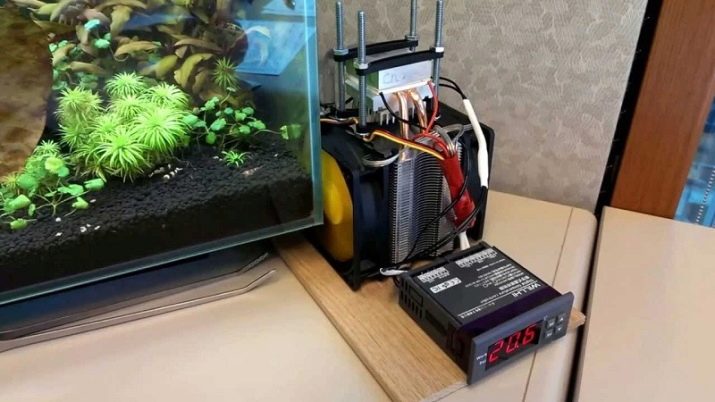
What does it lead to?
In their natural habitat, fish are able to adapt to a smooth change in the temperature of an artificial reservoir. In an aquarium, these changes occur much more rapidly due to the small amount of liquid. For this reason, in summer, the water requires cooling to maintain the underwater microclimate of fish and vegetation.
In summer, the temperature in the room rises rapidly, therefore, the liquid in the aquarium heats up rapidly. The high temperature in an artificial reservoir can lead to diseases, and sometimes even to the death of underwater inhabitants. Some fish species tolerate a temperature range of 15 to 30 degrees. but for keeping tropical fish species, an indicator of up to 27 degrees is acceptable... If the temperature is higher than this indicator, then the fish stop eating and become inactive.
The increased temperature adversely affects the life of snails and vegetation. For this reason, a thermometer is required to monitor the temperature in the aquarium.
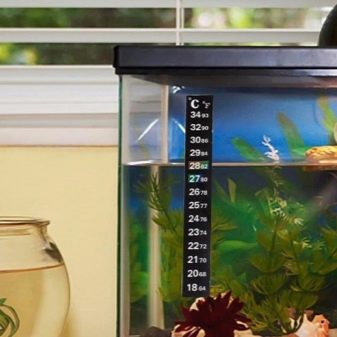
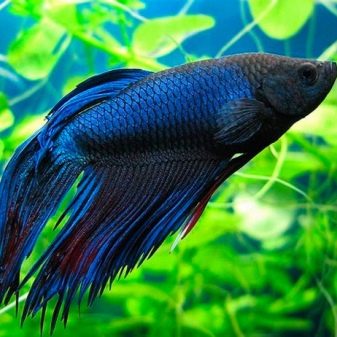
Strong heating leads to some negative consequences.
- The amount of oxygen decreases, the amount of carbon dioxide increases, which does not have a beneficial effect on the health of the fish.
- Since fish do not have body temperature regulation, when the water is heated, metabolic processes are accelerated. This leads to rapid deterioration of the body.Death can occur from the refusal of any organs or from suffocation.
- The heated water promotes the rapid decomposition of the waste products of the inhabitants of the aquarium. Toxic substances are released, which are equivalent to poison.
- Beneficial bacteria live in the cleaning filter. Heating water can lead to their death.
- Heating the liquid increases salinity, which causes various diseases in underwater inhabitants.
- The heated water fails the equipment intended for the aquarium.
By the behavior of underwater inhabitants, one can immediately determine the overheating of the water. At elevated temperatures, fish rise to the upper layers of the water and try to swallow air. Overheating of the liquid leads to the fact that they become lethargic and lie on the bottom.
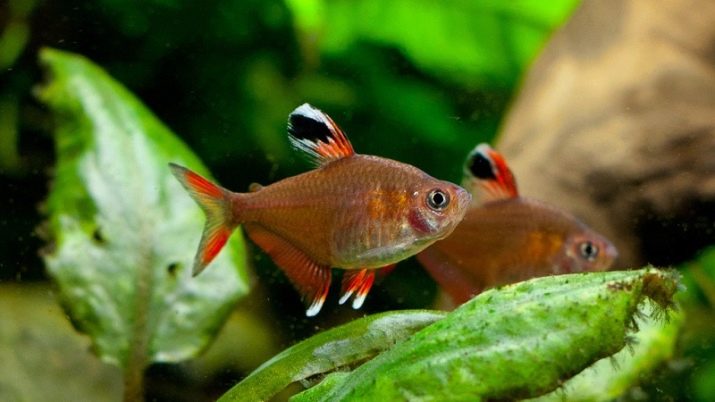
Cooling methods
To lower the room temperature, should turn on the air conditioner... If there is no air conditioner in the room, then you need to close the windows with curtains made of thick fabric, which does not allow sunlight to pass through. If the container is near a window and sunlight falls on it, you need to move it to another place.
Another solution would be use of a special film that protects windows from overheating... This film can also be glued to the walls of the aquarium.
Can wrap the aquarium with a damp towel or thick cloth and moisten it periodically as it dries. Thus, evaporation will occur, which will lead to cooling of the container. You can also open the lid of the container. This will lead to the effect of evaporation, and then to cooling. To prevent the fish from jumping out, you should tighten the aquarium with gauze or a thin cloth.
In hot weather, turn off the aquarium lights, which are a source of heat for the fish.
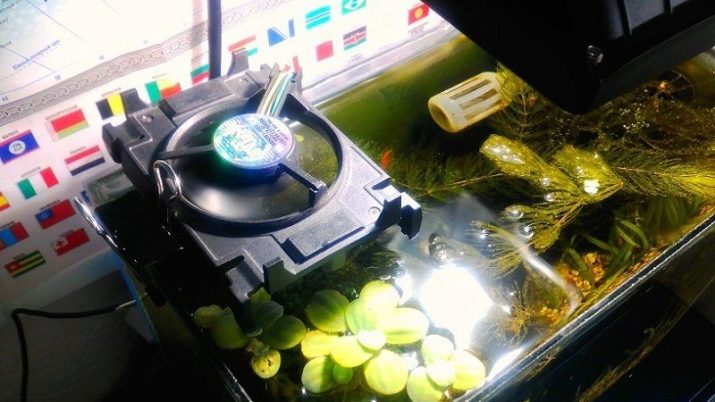
Frequent water changes will help cool the liquid in an artificial reservoir. This should be done smoothly throughout the day and the water should be changed in small parts (10-15%). With a sharp change, the fish can be stressed, and the beneficial bacteria will die.
Ice is used to cool the liquid in the aquarium. There are several methods for this cooling. They are presented below.
- Change the contents of the filter to ice. Thus, the water in the aquarium cools down rather quickly: within 10 minutes. In this case, you need to monitor the temperature. A sharp decline can lead to the death of shellfish and some fish species.
- Ice bottles. First, you should freeze water in a plastic bottle or fill it with ready-made ice. The bottle must be placed in the aquarium. The liquid cools down gradually. With this method, you should also observe the decrease in the temperature indicator. Using this method leads to the loss of the aesthetic appearance of the aquarium.
For cooling, you can turn on ordinary household fan. It is enough to direct it to the water surface of an artificial reservoir. However, in extreme heat, it will not work to significantly cool the liquid using this method. The disadvantage of using a fan is the rapid evaporation of water.
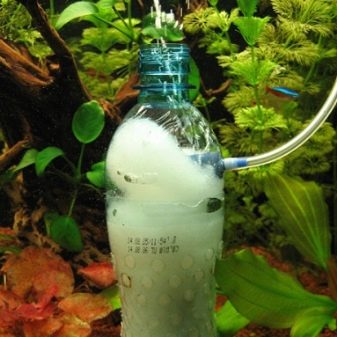
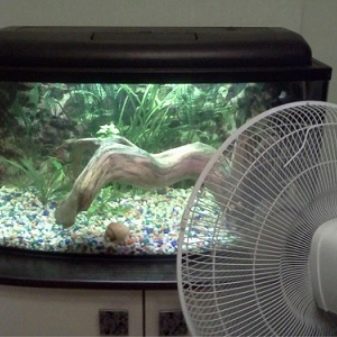
Influence of aquarium size on water heating
If we are talking about how to cool water in an artificial reservoir, then the question immediately arises of how much water we are talking about. In small aquariums, the liquid heats up very quickly, but the water in the aquarium also cools faster. As for large options, it is very difficult to heat and cool water in such containers.
The best option would be aquariums with a volume of 300 to 500 liters. Such a volume of liquid keeps the optimum temperature much longer. In these aquariums, the fish have the opportunity to descend to the bottom layers and survive the extreme heat there. For this reason if there is no air conditioner in the room, then such containers should be chosen.
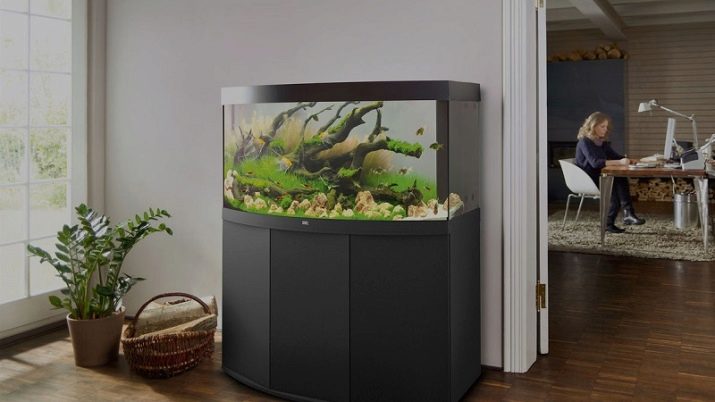
Aeration
The aeration method is mixing layers of water with oxygen bubbles. In natural conditions, this happens due to the flow of water, gusts of wind and vegetation.For aeration at home, special filters, pumps and compressors are used.
In the summer heat, aeration is very important for the aquarium. If there is a filter in the container, then a special nozzle-tube is attached to it. The filter must be placed near the surface of an artificial reservoir. Thus, streams of water will be pushed to the surface, thereby increasing the enrichment of the liquid with air.
But it should be borne in mind that this method can only slightly cool the water in a glass house. For too hot water, the method is considered ineffective.

Modern ways
The modern cooling method is aquarium cooling system... Such a professional refrigeration system allows you to cool the water in the aquarium as much as necessary. The decrease in temperature occurs safely and without sudden jumps, while the equipment allows you to monitor other parameters of the aquatic environment. The disadvantage of such equipment is its high cost.
The available solution is using a computer fan... It can be installed on the lid next to the lighting fixtures. This method not only helps to cool the water - due to the movement of air, the layers of water vibrate, which leads to the saturation of the liquid with oxygen.
The use of coolers such as special coolers for aquarium, helps to significantly cool the water. Evaporation of the liquid leads to a decrease in the temperature of the water in the artificial reservoir. A more effective way is to use several devices: one fan drives the air currents, and the other pulls them out.
Chiller - refrigeration unit for aquariums... A kind of refrigerator works automatically, it allows you to stabilize the temperature and maintains an optimal indicator for a long time. The advantage of the equipment is its silent operation. Of the minuses, the high price of the device is noted. In addition, such a cooling model is more suitable for large containers with a variety of fish and plants.
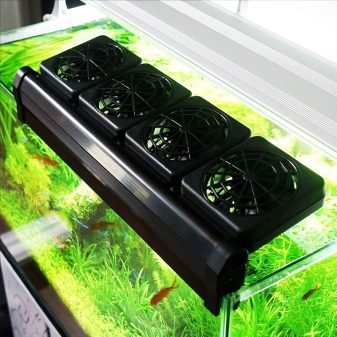
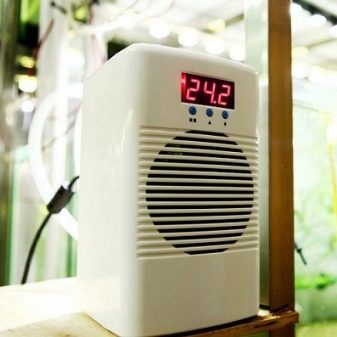
The optimum temperature of the liquid in the aquarium is important for the proper functioning of fish, vegetation and beneficial bacteria. During the summer, it is especially important to maintain a stable temperature and avoid overheating.
All the described recommendations and methods will help to achieve a slight cooling of the liquid. But it should be borne in mind that in intense heat, many methods may not work... In this case, you can use several methods at once. In this case, it is necessary to monitor the temperature indicator and prevent sudden changes.
For information on how and how to cool the water in the aquarium, see the next video.








